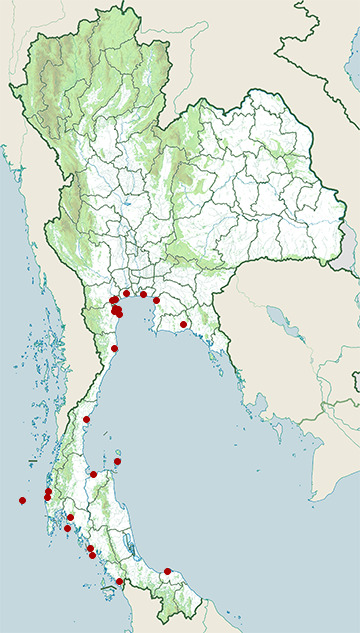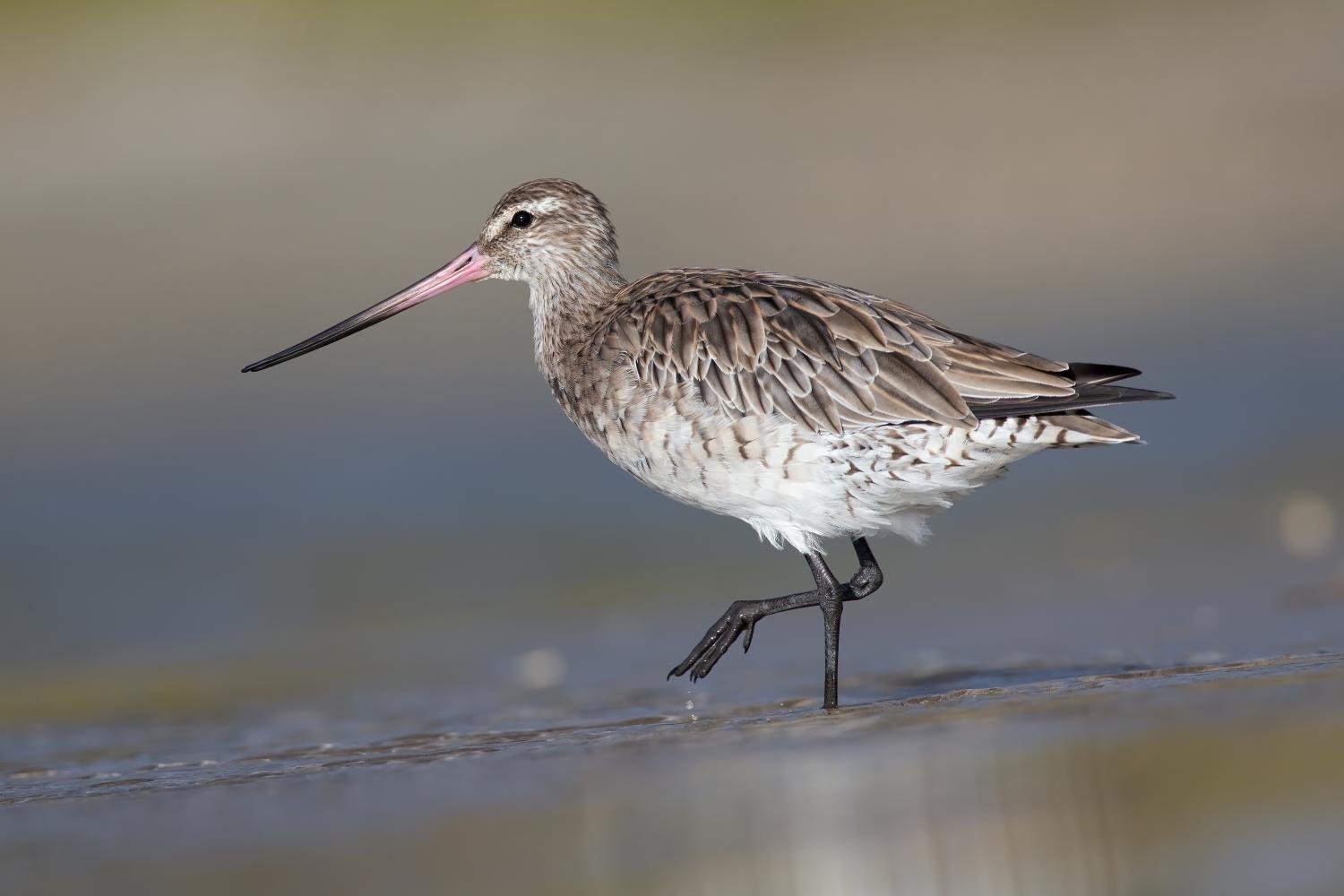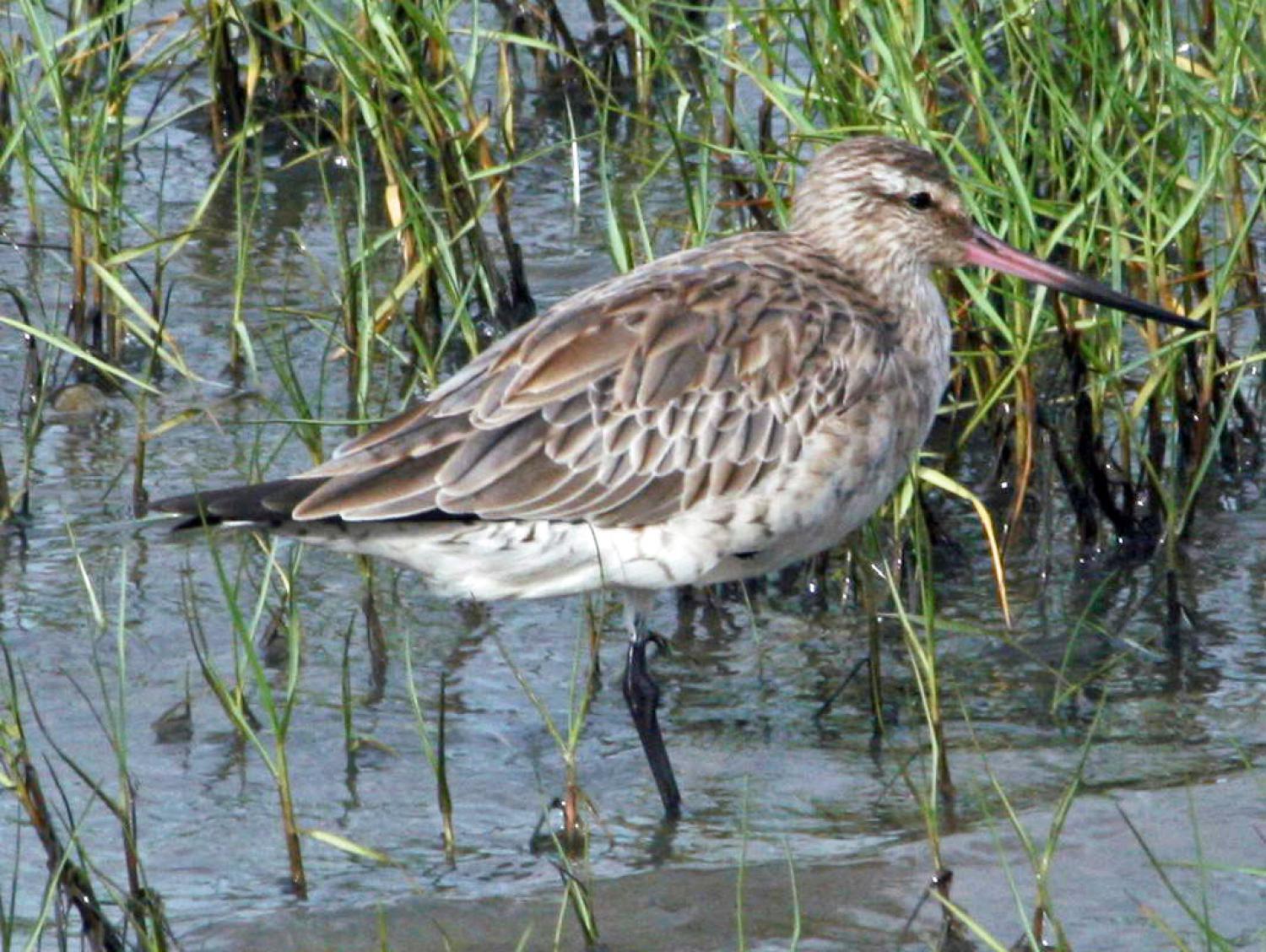Species of Thailand
Bar-tailed godwit
Limosa lapponica
Carolus Linnaeus, 1758
In Thai: นกปากแอ่นหางลาย
The bar-tailed godwit (Limosa lapponica) is a large wader in the family Scolopacidae, which feeds on bristle-worms and shellfish on coastal mudflats and estuaries. It has distinctive red breeding plumage, long legs, and a long upturned bill. Bar-tailed godwits breed on Arctic coasts and tundra from Scandinavia to Alaska, and overwinter on coasts in temperate and tropical regions of the Old World, Australia and New Zealand. The migration of the subspecies Limosa lapponica baueri from across the Pacific Ocean from Alaska to New Zealand is the longest known non-stop flight of any bird, and also the longest journey without pausing to feed by any animal. The round-trip migration for this subspecies is over 29, 000 km.
Name
The genus name Limosa is from Latin and means "muddy", from limus, "mud", referring to its preferred habitat. The specific name lapponica refers to Lapland: it was originally named Scolopax lapponica by Linneaus from a northern Swedish specimen.
The English term "godwit" was first recorded in about 1416–17 and may be an imitation of the bird's call, or be derived from the Old English "god whit", meaning "good creature", perhaps referring to its eating qualities. Its English name is taken from the black-and-white barred tail and upper tail coverts in this species. In French it is known as barge rousse, Russian maliy veretennik, Inuit chiuchiuchiak, Yup'ik tevatevaaq, and Māori kūaka.
Description
The bar-tailed godwit is a relatively short-legged species of godwit. The bill-to-tail length is 37 - 41 cm, with a wingspan of 70 - 80 cm. Males average smaller than females but with much overlap; males weigh 190 - 400 g, while females weigh 260 - 630 g; there is also some regional variation in size (see subspecies, below). The adult has blue-grey legs and a long, tapering, slightly upturned bi-colored bill: pink at the base and black towards the tip. The neck, breast and belly are unbroken brick red in breeding plumage, and dark brown above. Females breeding plumage is much duller than males, with a chestnut to cinnamon belly. Breeding plumage is not fully apparent until the third year, and there are three distinguishable age classes; during their first migration north immature males are noticeably paler in colour than more mature males. Non-breeding birds seen in the Southern Hemisphere are plain grey-brown with darker feather centres, giving them a striped look, and are whitish underneath. Juveniles are similar to non-breeding adults but more buff overall with streaked plumages on flanks and breast.
Alaska-breeding bar-tailed godwits show an increase in body size from north to south, but this trend is not apparent in their non-breeding grounds in New Zealand; birds of different sizes mix freely.
Limosa lapponica is distinguished from the black-tailed godwit (Limosa limosa) by its black-and-white horizontally-barred (rather than wholly black) tail, and lack of white wing bars. The most similar species is the Asiatic dowitcher (Limnodromus semipalmatus).
There are now five generally accepted subspecies of bar-tailed godwit, listed from west to east:
- L. l. lapponica - (Linnaeus, 1758): Breeds from northern Scandinavia east to the Yamal Peninsula; winters western coasts of Europe and Africa from the British Isles and the Netherlands south to South Africa, and also around the Persian Gulf. Smallest subspecies, males up to 360 g, females to 450 g.
- L. l. taymyrensis: Engelmoer & Roselaar, 1998: Breeds in central Siberia from the Yamal Peninsula east to the Anabar River delta.
- L. l. menzbieri - Portenko, 1936: Breeds northeastern Asia from the Anabar River east to the Kolyma River delta; winters in Australia.
- L. l. anadyrensis: Engelmoer & Roselaar, 1998: from the Anadyr lowlands in far northeastern Asia east of the Kolyma River; the second largest subspecies, smaller than L. l. baueri
- L. l. baueri - Naumann, 1836: (called ) Breeds in western Alaska; winters in Australia and New Zealand. Largest subspecies.
,
Diet
The birds' main source of food in wetlands is bristle-worms (up to 70%), supplemented by small bivalves and crustaceans. In wet pastures, bar-tailed godwits eat invertebrates. In a major staging site in the northern Yellow Sea, they continue to hunt polychaetes, but most of their food intake is the bivalve mollusc Potamocorbula laevis, which they generally swallow whole.
Male bar-tailed godwits are smaller than females and have shorter bills. In a study at the Manawatū Estuary, shorter-billed birds (males) fed mostly on small surface prey like Potamopyrgus snails, half being snail specialists, whereas females consumed more deeply-buried prey such as worms; the birds also displayed some individual food preferences.
Breeding
The bar-tailed godwit is a non-breeding migrant in Australia and New Zealand. Birds first depart for their northern hemisphere breeding sites at age 2–4. Breeding take place each year in Scandinavia, northern Asia, and Alaska. The nest is a shallow cup in moss sometimes lined with vegetation. Clutch size is from 2 to 5, averaging four. Both sexes share incubation of the eggs for 20 to 21 days, the female during the day and the male at night.
Migrations
All bar-tailed godwits spend the Northern Hemisphere summer in the Arctic, where they breed, and make a long-distance migration south in winter to more temperate areas. L. l. lapponica make the shortest migration, some only as far as the North Sea, while others travel as far as India. Bar-tailed godwits nesting in Alaska (L. l. baueri) travel all the way to Australia and New Zealand. They undertake the longest non-stop migrations of any bird, and to fuel this carry the greatest fat loads of any migratory bird so far studied, reducing the size of their digestive organs to do so.
L. l. bauri breeds in Alaska and spends the non-breeding season in eastern Australia and New Zealand. L. l. menzbieri breeds in Siberia and migrates to northern and western Australia. Birds breeding in Siberia follow the coast of Asia northwards and southwards, but those breeding in Alaska migrate directly across the Pacific to Australasia 11, 000 km away. To track the return journey, seven birds in New Zealand were tagged with surgically-implanted transmitters and tracked by satellite to the Yellow Sea in China, a distance of 9575 km; the actual track flown by one bird was 11026 km, taking nine days. At least three other bar-tailed godwits also appear to have reached the Yellow Sea after non-stop flights from New Zealand.
One specific female of the flock, nicknamed "E7", flew onward from China to Alaska and stayed there for the breeding season. Then in August 2007 she departed on an eight-day non-stop flight from western Alaska to the Piako River near Thames, New Zealand, setting a new known flight record of 11680 km. This L. l. bauri female made a 174 day round-trip journey of 29, 280 km with 20 days of flying.
To fuel such long journeys, L. l. baueri birds in New Zealand deposit much more fat for their body size than other subspecies, allowing them to fly 6, 000 to 8, 600 km. Both Australasian subspecies head north to their breeding grounds along the coast of Asia to the Yalu Jiang coastal wetland in the north Yellow Sea, the most important staging grounds for godwits and great knots (Calidris tenuirostris) in their northern migration. Baueri birds rested for about 41 days before continuing approximately 7000 km on to Alaska. Menzbieri spent on average 38 days in the Yellow Sea region and flew an additional 4100 km to high Arctic Russia.
Birds will often depart early from New Zealand if there are favourable winds; they seem to be able to predict weather patterns that will assist them on the entire migration route. Birds that had nested in southern Alaska were larger and departed New Zealand earliest; this pattern was repeated six months later, with birds departing Alaska in the same order they arrived, and over the same span of days. Birds in southern New Zealand departed on average 9–11 days earlier than birds in more northern sites. Godwits arrive at the Yukon-Kuskokwim Delta in Alaska in two waves; local breeders in early May, and larger flocks in the third week of May en route to breeding grounds further north.
Protection
The status of the bar-tailed godwit is Near Threatened, and the population is declining. Fewer birds have been using East African estuaries since 1979, and there has been a steady decline in numbers around the Kola Peninsula, Siberia, since 1930. The global population is estimated to number 1, 099, 000–1, 149, 000 individuals.
Both L. l. bauri and L. l. menzbieri adult survival rates decreased between 2005 and 2012, probably because of the loss of intertidal staging areas in the Yellow Sea. The construction of seawalls and the reclamation of mudflats have led to a critical reduction in food supplies for migrating birds, particularly subspecies like L. l. menzbieri that rely on the Yalu Jiang estuary on both their northward and southward migrations. Numbers of L. l. baueri have declined in New Zealand from over 100, 000 in the late 1980s to 67, 500 in 2018.
The bar-tailed godwit is one of the species to which the Agreement on the Conservation of African-Eurasian Migratory Waterbirds (AEWA) applies. In New Zealand the species is protected under the 1953 Wildlife Act.
This article uses material from Wikipedia released under the Creative Commons Attribution-Share-Alike Licence 3.0. Eventual photos shown in this page may or may not be from Wikipedia, please see the license details for photos in photo by-lines.
Category / Seasonal Status
Wiki listed status (concerning Thai population): Winter visitor
BCST Category: Recorded in an apparently wild state within the last 50 years
BCST Seasonal status: Non-breeding visitor
Scientific classification
- Kingdom
- Animalia
- Phylum
- Chordata
- Class
- Aves
- Order
- Charadriiformes
- Family
- Scolopacidae
- Genus
- Limosa
- Species
- Limosa lapponica
Common names
- English: Bar-tailed godwit
- French: Barge rousse
- Thai: นกปากแอ่นหางลาย
Conservation status

Least Concern (IUCN3.1)

Near Threatened (BirdLife)

Near Threatened (ONEP)

Near Threatened (BCST)
Photos
Please help us review the bird photos if wrong ones are used. We can be reached via our contact us page.
Range Map

- Amphawa District, Samut Songkhram
- Ban Laem District, Phetchaburi
- Bang Pu Recreation Centre
- Chumphon Coast
- Hat Chao Mai National Park
- Khao Lak - Lam Ru National Park
- Khao Sam Roi Yot National Park
- Klaeng District, Rayong
- Ko Libong
- Ko Samui District, Surat Thani
- Laem Pak Bia
- Mueang Chonburi District, Chonburi
- Mueang Krabi District, Krabi
- Mueang Pattani District, Pattani
- Mueang Phetchaburi District, Phetchaburi
- Mueang Samut Sakhon District, Samut Sakhon
- Mueang Samut Songkhram District, Samut Songkhram
- Mueang Satun District, Satun
- Pak Thale
- Phi Phi Islands
- Similan Islands
- Surat Thani Coast
- Takua Pa District, Phang Nga





